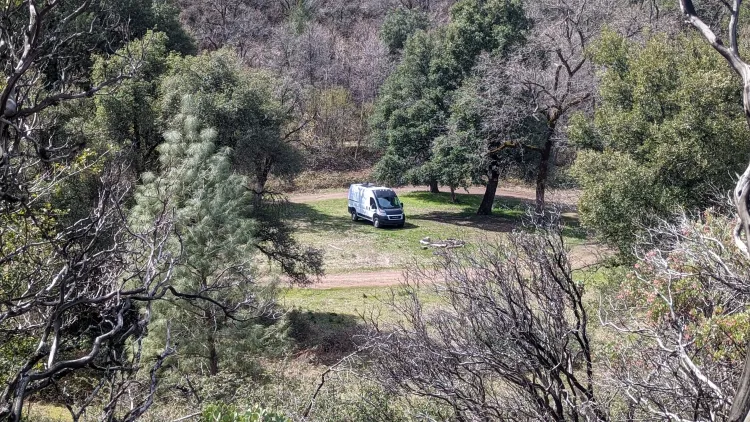How Digital Nomads Get Internet

Being a digital nomad is a freeing experience. You can choose to work where you want, and can even make your own hours. One critical factor to working as a digital nomad is having access to the internet. How do digital nomads get internet?
Digital nomads can access the internet in many different ways. They can get internet from coffee shops, rentals/ hotels, phone plans, hot spots, and even through satellite. There are many options to ensure you can stay connected while travelling!
Table Of Contents
Can It Wait?
Coffee Shops And Restaurants
Co-Working Spaces
Rentals And Hotels
Phone Tethering
Hot Spots
Satellite
Public
Conclusion
Can It Wait?
One of the easiest ways to work is to respond, upload, update and plan as you come across internet as opposed to needing to be around it at all times. Being able to connect to do your required work when it is more convenient makes your time more flexible. I've spoken about balancing work and leisure and how much I love being able to have days of heavy work, and days of heavy relaxation.
Working this way can allow you to work on your responsibilities offline, and then peek out of the woods for a few hours or on top of a hill to upload what you've been working on. Or you might be able to do all the filming you need while out of cell service, and even edit before you return to civilization.
Of course, if you deal with people, this might not be the best solution. You might need to be more anchored to infrastructure when dealing with clients, or need to promptly respond to emails. Or perhaps you need to source information online while working on the landing page of your website. If you're in this category, there are a plethora of options.
Coffee Shops And Restaurants
Coffee shops were the original digital nomad stomping grounds. It isn't uncommon to walk into a Starbucks and see people who look like they nearly live there. However, this approach comes with some nuances.
When you choose to work in a space that has free internet for its patrons, you usually need to buy something to do just that. It's like renting a workspace for the price of a burger or a coffee. Lots of people love coffee, so it seems like a no-brainer to work in this type of space. These places are often set up to facilitate this with decent internet and plugs everywhere.
Some issues exist where places place a limit on how long you can stay, or how long you have access to the internet. Because of these issues, they can't always be a reliable source of internet. Sometimes these places will be experiencing internet issues throwing a wrench in your entire plan to work there.
Another concern might be privacy and conduciveness for work. These places are usually shared by many others. Sometimes dogs, kids, cackling groups of mothers taking a break, and people playing music on their phones. They don't always provide the best quiet space you might need to get your work done. If that's the case, and you have no other options, think about facing a wall and investing in some quality noise-cancelling headphones!
Despite these issues, coffee shops and restaurants can usually be depended on for a quality internet connection. Sometimes they have rules limiting how long you can stay. They're also not always the most conducive space to work, but they will work for most people.
Co-working Spaces
Co-working spaces can be seen as the logical evolution of coffee shops. It solves problems like needing to buy a drink to sit at a location. It also deals with the issue of needing a more professional space to work from. While the concept is focused on providing you with a space for productivity, they also come with some negatives.
Co-working spaces exist for those that don't need a company office to work. They're typically populated by those who only need an office-type space part-time, and many digital nomads. They exist in many places. Some benefits of co-working spaces are you end up in a space that is dedicated to working and like-minded people are there too. There are faux pas' about excessive noise and unruliness and emphasis on productivity.
Using these spaces usually means paying to do so. They are more expensive than going to a coffee shop. However, they will provide a more dedicated workspace and reliable infrastructures like connectivity, power, and space. Check out Nomadlist's cost of living section to get a sense of what they might cost in different areas!
Rentals And Hotels
Once upon a time, before wireless internet was so prominent, hotels had business centers (some still do). These business centers came with phones, printers, computers, etc. Relying on your accommodations to be your connection to the world is another great option. Most hotels can guarantee internet, and even some Airbnbs now flaunt their connection speed on their listings.
Hotels and rentals are usually great places to get reliable internet. Some have dedicated workspaces in them. Other places might be not so well set up meaning you'll need to work while laying in bed. It's pretty common now to come across Airbnb listings stating their internet connection speed. This can allow you to plan better and find a place where you don't need to wait 4 hours to upload your video, or you can better plan if you'll be able to watch Netflix in the background while working on a more professional task.
Your accommodations provide a great option for staying connected. Having the cost of the internet built into your home also saves some money if you're travelling frugally. You can usually count on these places when planning how you'll get your work done while on the go.
Phone Tethering
Now we get into the highly mobile sources of internet. Most people carry phones nowadays, and they can act as a hot spot/ tether for electronic devices. While this option is extremely convenient and allows you to be highly mobile, there are some issues with going this route.
Most times, you can share your phone's internet plan with other devices. Working like this provides a ton of flexibility on where you're physically located. Be mindful that this type of connection will rely on you actually having an adequate cell/ data connection. Having this option allows you to even work on a beach (Let's be honest, this isn't always a great way to work with the sun's glare, the wind blowing your documents around, and getting sand in the keyboard and vent of your laptop). You can also work from a trailhead or some spot with service in an FSR before hiking back into your site for the night or sending a quick email before driving out of service. Apps like iOverlander often have reviews of locations with people mentioning the quality of reception in the area.
I've seen many phone plans that limit how much you're able to tether. Sometimes they place limits on how much of your data you can use while tethering. This can be incredibly frustrating when they micro-manage what you use your internet on that you paid for. Researching a good phone plan can ensure you don't run into these types of issues.
Hot Spots
There exists a more specific tool than tethering off your phone. Hot spots are a solution to some of the issues with using your phone as your source of internet. They can be highly convenient and allow you to remain connected while working nomadically.
Hot spots are similar to using your phone, but they are a dedicated connection that can be connected to like wifi. They usually come with beefier data limits and cost a bit more for the service they provide. Oftentimes, you will need a sim card for these devices. Because of that, they often rely on the same network as your phone carrier. So, if you don't have cell service, chances are the hot spot won't either.
These devices can be a convenient option for connecting. They can provide you with a backup to your phone if that's not adequate. However, they do have their limitations.
Satellite
An option that has surfaced recently is satellite internet. Nowadays, you can connect to the internet almost anywhere in the world if you bring along a satellite. While this option isn't great for those living out of a backpack, it has worked wonders for those travelling in a van or living more off-grid.
The main company providing satellite internet right now is Starlink. They provide an incredibly robust service. It comes with a router and the satellite itself. Recently, their plans even opened up to having access to the internet on the go, as in being able to change sites more than once a day.
This company has proved its reliability by donating its units to those in need. They've sent them to those who have experienced complete disruptions from the outside world like the Tonga eruption. They've also sent units to Ukraine to replace their destroyed infrastructure due to the regional conflict.
Some drawbacks to this option are the requirement to power the system and the cost. It's quite an elaborate piece of tech and will need power to keep it operational. Another con is the price. Not only do you need to pay for the unit, but you also need to pay for a monthly subscription. Despite those drawbacks, it can be worth it if you need a robust, fast, reliable connection in places where there are no other options.
Public

Lastly is the option of using the internet that is available publicly. This option is often less reliable and comes with some major pitfalls. If all else fails, it can work but I wouldn't recommend depending on it when your income is potentially at stake.
This option exists at places like libraries, bust stops, museums, etc. Some of these are great options. But when you're trying to rely on free public wifi while sitting on a park bench, you might have some issues. They might have caps on how much data you can use. They can also be frustratingly slow. Sometimes they even limit you to what apps you can use.
In a pinch, sending an email this way or sourcing a quote or information online is a great option. Relying on this wouldn't be the best idea since these connections can be quite unstable and limiting.
Conclusion
We now live in the future, and connectivity is really important. There are a plethora of options for travellers and digital nomads alike to connect to the internet. Some are worse than others, while some can be better than your home internet. There are ways to connect frugally and ways to connect closely resembling a typical office space. With all the options explained in this post, you will have a better understanding of how digital nomads can get work done while on the move!






Member discussion